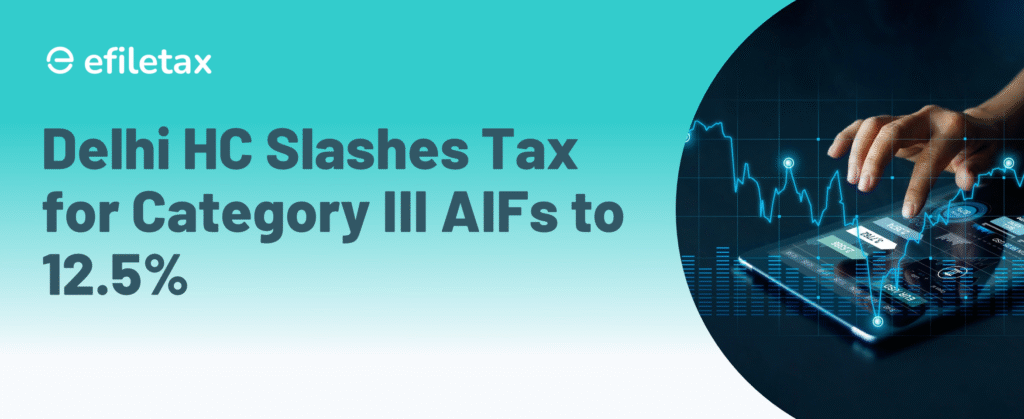
Category III AIFs Get Tax Relief: What the Delhi HC Ruling Means
The Delhi High Court has granted major tax relief to Category III AIFs, ruling on 29 July 2025 that a 2014 CBDT circular is ultra vires. This brings down the tax rate from the Maximum Marginal Rate (MMR) of 40% to just 12.5%, echoing earlier decisions from Karnataka and Madras High Courts. The judgment directly impacts over ₹2.3 trillion in managed assets and investor trust in the Indian fund ecosystem.
What Are Category III AIFs?
Category III Alternative Investment Funds are SEBI-registered entities that:
- Use complex or leveraged strategies (e.g., hedging, arbitrage)
- Invest in listed and unlisted derivatives, debt, and equity
- Include hedge funds, PIPE funds, and other high-risk/high-return vehicles
These funds are structured as trusts, and the tax pass-through status has long been debated.
CBDT Circular 7/2014: The Root of the Dispute
In CBDT Circular No. 7/2014 dated 15.07.2014, the department said Category III AIFs could not claim tax pass-through status under Section 115UB unless each investor was named in the trust deed.
But under SEBI (AIF) Regulations, 2012, this isn’t allowed — investor details are confidential and dynamic. So the circular became impractical and legally inconsistent.
Key Highlights of Delhi High Court’s Ruling
| Aspect | Delhi HC Verdict |
|---|---|
| CBDT Circular 7/2014 | Held ultra vires to Income Tax Act, 1961 |
| Investor naming requirement | Found in conflict with SEBI norms |
| Tax implication | Category III AIFs eligible for 12.5% rate, not 40% MMR |
| Legal consistency | Aligns with Karnataka HC (2022) and Madras HC (2023) |
| Practical impact | Brings relief to ₹2.3 lakh crore AIF corpus as of March 2025 |
| Future outlook | CBDT may issue a nationwide clarification post this ruling |
Focus Keyphrase in Use: Category III AIFs
The Delhi HC ruling on Category III AIFs directly resolves a long-pending tax dilemma. It recognizes the SEBI-compliant fund structures and safeguards investor anonymity, a cornerstone of fund operations.
Legal Reference
- CBDT Circular No. 7/2014, dated 15 July 2014
- SEBI (AIF) Regulations, 2012
- Delhi High Court Judgment – Intermediary Investment Trust v. CBDT, decided 29 July 2025
- Earlier supporting rulings:
- IIFL Fund v. CIT (Karnataka HC, 2022)
- TVS Capital v. UOI (Madras HC, 2023)
Expert Tip: What Fund Managers Should Do Now
Fund managers of Category III AIFs should:
- Reassess tax provisioning for FY 2022–23 onward
- Review trust deeds and fund documents for alignment with SEBI norms
- Await CBDT’s clarificatory circular, which may apply this ruling nationwide
- Consider filing rectification/appeal in pending assessments using this judgment
Why This Ruling Matters
- Avoids double taxation at trust and investor level
- Supports capital market stability by boosting investor confidence
- Makes India a more tax-friendly jurisdiction for fund houses
- Reinforces the checks and balances between tax authorities and judicial review
FAQs
Q1: Does this judgment apply automatically across India?
Not yet. Until CBDT issues a pan-India clarification or the Supreme Court affirms it, other jurisdictions may not apply it by default.
Q2: Can AIFs now file refund claims?
Yes, if excess tax was paid under MMR due to the earlier circular, refund applications may be filed within the limitation period.
Q3: Will this ruling benefit all AIF categories?
No. This applies specifically to Category III AIFs. Categories I and II have different tax treatments.
Summary
Delhi HC strikes down CBDT’s 2014 circular on Category III AIFs, lowering tax from 40% to 12.5%. Major win for SEBI-registered funds managing over ₹2.3 lakh crore.
Final Word
The Delhi High Court’s bold stand on Category III AIFs taxability is a win for legal consistency and investor protection. For professionals managing or investing in AIFs, this judgment signals a turning point.
Need help navigating tax compliance or assessment under Section 115UB?
Efiletax simplifies it. Reach out now and safeguard your fund’s tax position.